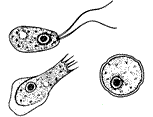Naegleria fowleri
Jump to navigation
Jump to search
For the course duration, the article is closed to outside editing. Of course you can always leave comments on the discussion page. The anticipated date of course completion is May 21, 2009. One month after that date at the latest, this notice shall be removed. Besides, many other Citizendium articles welcome your collaboration! |
| Naegleria fowleri | ||||||||||||||||
|---|---|---|---|---|---|---|---|---|---|---|---|---|---|---|---|---|
 Different stages of Naegleria fowleri
| ||||||||||||||||
| Scientific classification | ||||||||||||||||
| ||||||||||||||||
| Binomial name | ||||||||||||||||
| Naegleria fowleri Carter (1970) |
Description and significance
Naegleria fowleri (commonly known as the “brain-eating amoeba) is a free-living protist found in moist environments (25-35 degrees Celsius) including soil, sewage, or warm fresh water. It is a member of the Percolozoa phylum and exists in the alternating states trophozoite, cyst, and flagellate. N. fowleri can cause the rare but fatal disease primary amoebic meningoencephalitis (PAM) when it enters the human nervous system.